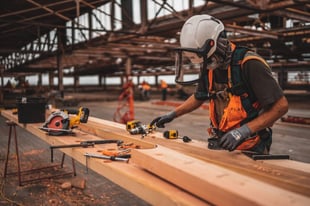Addressing the Construction Labor Shortage with Innovative Preconstruction Solutions

The construction industry faces a significant challenge in the form of a construction labor shortage affecting project timelines, costs, and overall productivity. With a high demand for skilled workers and a limited supply of qualified labor, construction firms are struggling to meet growing needs. This shortage is particularly true for trades requiring specialized skills, such as electricians, plumbers, and carpenters, all of which are important to the success of construction projects. According to Associated Builders and Contractors (ABC) Chief Economist Anirban Basuv, “More than 1 in 5 construction workers are 55 or older, meaning that retirement will continue to contract the industry’s workforce. These are the most experienced workers, and their departures are especially concerning.”
In response to these challenges, preconstruction planning has emerged as a solution to address the labor shortage. Preconstruction solutions can help bridge the skills gap and improve project success by optimizing workforce utilization, leveraging technology, and enhancing workforce training. Let’s explore how preconstruction strategies can mitigate the effects of the skilled labor shortage and ensure projects are completed on time and within budget.
The Scope of the Labor Shortage in Construction
The construction labor shortage has worsened over the past decade. According to ABC, the labor market for construction workers has become increasingly strained, with job openings exceeding the number of available qualified candidates. As a result, builders and contractors are left to grapple with the effects of a worker shortage that drives up wages and slows down project completion rates.
The labor force participation rate in the construction sector has declined over the past few decades, further exacerbating the skilled labor shortage. As Basu noted, the aging workforce is a key factor contributing to this trend, with many seasoned workers retiring without enough new talent to replace them. This issue is pressing, as the construction industry is expected to experience steady growth over the next several years, increasing the demand for qualified workers even further.
The great resignation also compounded the problem, as many workers in the construction sector, like in other industries, reevaluated their careers during the COVID-19 pandemic and opted for alternative fields with more flexible work options or better job security, such as health care. The migration of workers from physically demanding roles in construction to less strenuous work in other sectors has intensified the labor shortage in the industry.
How Preconstruction Solutions Address the Labor Shortage
To address these challenges, construction firms must adopt innovative strategies that optimize the utilization of the existing workforce while preparing for future labor demands. Preconstruction planning is important in this process because it allows teams to manage labor resources more effectively and reduce skill gaps that could hinder project progress.
Here are some tips for construction firms looking to mitigate the labor shortage.
1. Optimize Workforce Utilization through Digital Tools
One of the most effective ways to manage the skilled labor shortage is to leverage technology to improve workforce utilization. Tools like DESTINI Estimator can assist in this process by providing real-time data and predictive analytics to help construction firms allocate resources more efficiently. By incorporating labor availability, skill requirements, and project timelines into the estimation process, preconstruction teams can ensure that the right workers are assigned to the right tasks, minimizing downtime and maximizing productivity.
Additionally, digital tools can help track labor costs, allowing project managers to adjust budgets based on labor availability. This allows for better decision-making and more accurate forecasts, ensuring projects stay on budget even when labor costs fluctuate.
2. Improve Efficiency through Prefabrication and Modular Construction
Another innovative solution to the labor shortage is prefabrication and modular construction. Construction firms can reduce on-site labor requirements by assembling components off-site and transporting them to the project location. This method mitigates the impact of labor shortages and speeds up the construction process, as pre-assembled modules can be installed much faster than traditional building methods.
By incorporating prefabrication into the preconstruction phase, companies can reduce reliance on labor-intensive tasks, such as framing and assembly, and instead focus on more specialized areas where skilled labor is required. This approach helps reduce the strain on the workforce and improves project timelines.
3. Implement Smart Scheduling and Labor Forecasting
Preconstruction planning also involves forecasting labor needs based on project requirements and available workers. Smart scheduling, powered by artificial intelligence (AI) and machine learning algorithms, allows project managers to predict when and where labor will be needed throughout the project lifecycle. By analyzing historical data and trends, these tools can help construction firms anticipate labor demands, enabling them to plan ahead and address potential skill gaps.
This technology allows teams to identify bottlenecks in the construction process before they occur, enabling them to hire workers with the right skills at the right time. By aligning labor availability with project needs, firms can optimize labor market resources and ensure smoother project execution, even in the midst of labor shortages.
4. Enhancing Workforce Training and Development
The skilled labor shortage in construction is partly due to the lack of training opportunities for new workers. To address this, apprenticeship programs and on-the-job training initiatives should be a central focus during the preconstruction phase. These programs offer a structured learning environment where apprentices can gain hands-on experience while working under the supervision of skilled professionals.
In addition to traditional apprenticeship programs, construction firms can invest in careers in construction initiatives to attract younger workers to the industry. By showcasing the long-term benefits of a construction career - including competitive wages, job security, and opportunities for advancement - firms can help attract a new generation of workers.
Construction firms can also partner with trade schools, community colleges, and local workforce development organizations to create tailored training programs that align with industry needs. These programs should focus on areas with the greatest skills gaps, such as electrical work, plumbing, and welding, ensuring that workers are equipped with the skills needed to meet the demands of modern construction projects.
5. Attracting a Diverse Workforce
To address the labor shortage, construction firms must also expand their recruitment efforts to include underrepresented groups in the workforce. This includes targeting women, minorities, and veterans who may not have traditionally considered a career in construction. By promoting diversity and inclusion in the workplace, construction firms can tap into a broader talent pool and reduce reliance on a shrinking labor force.
Also, offering flexible work arrangements such as remote management positions or hybrid roles can help attract workers who may have been deterred by the physically demanding nature of traditional construction roles. By adapting to the needs of a diverse workforce, firms can increase their chances of filling labor gaps and addressing the skilled labor shortage.
The Role of Estimating Software in Labor Shortage Management
As mentioned earlier, tools like DESTINI Estimator play a vital role in managing the effects of the labor shortage on construction projects. By providing a platform for data-driven decision-making, DESTINI Estimator enables preconstruction teams to optimize labor resources, forecast labor needs, and track project progress in real time. This ensures that projects are completed on time and within budget, even when labor shortages persist.
Addressing the Construction Labor Shortage Head-On
The construction labor shortage requires firms to use innovative solutions to ensure continued success. Through effective preconstruction planning, construction firms can optimize labor utilization, reduce skill gaps, and improve workforce efficiency, all while mitigating the effects of labor shortages. By leveraging technology, implementing smart scheduling, and investing in training programs, the industry can address the current labor crisis and build a sustainable, skilled workforce for the future.
DESTINI Estimator and similar tools are essential in helping construction firms navigate these challenges. By using these technologies to forecast labor needs and track workforce utilization, companies can make informed decisions that reduce the impact of the skilled labor shortage on their projects, ensuring long-term success for workers and firms alike.

-1.png?width=112&height=112&name=image%20(4)-1.png)














